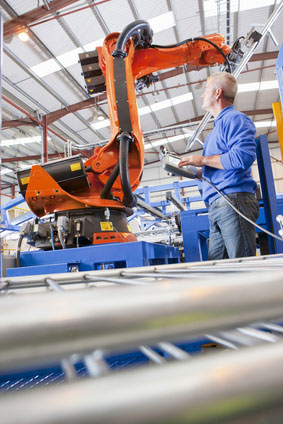KANBrief 2/15

Physical assistant robots, for which contact between a human being and the robot is intended, have now been joined by collaborative industrial robots that share the work space of the operating personnel. This raises the question of unintended contact with the latter, and the associated risks. The INRS discusses how these new areas of application can be brought into line with the 2006/42/EC Machinery Directive.
Development of robot technology and its applications in industry raises the question of how new forms of collaboration can be structured in which operating personnel and robots are allowed to act within the same work space during normal production whilst still assuring safety. The risk of unwanted contact between the robot and the human being exists both during production and during setup, maintenance, cleaning, etc. of the machine. How can the safety and health of the operating personnel be assured under these circumstances?
2006/42/EC Machinery Directive contains clear provisions
The Machinery Directive defines a "hazard" as a potential source of injury or damage to health (Annex I, Paragraph1.1.1, Definition (a)). In this context, "health" is to be understood in the widest sense and includes both physical (external and internal injuries) and mental effects.
Clear standards and prevention principles
Where danger presented by machinery is concerned, the provisions concerning prevention in EN ISO 12100, Safety of machinery – General principles for design – Risk assessment and risk reduction, and in other documents (for example: EN 614-1, Safety of machinery – Ergonomic design principles – Part 1: Terminology and general principles) are very clear. Preventive measures for the reduction of risks by means of inherently safe machinery also include the observance of ergonomic principles. The objective of these principles is for work equipment to be adapted to the needs, abilities and limits of human beings, and not vice-versa. Limitation of the contact forces has ceased to be a valid measure except for the avoidance of residual risks presented by powered guards (EN ISO 14120, Safety of machinery – Guards – General requirements for the design and construction of fixed and movable guards).
Thorough consideration of the principles stated shows beyond all doubt that limitation of the forces arising in the event of unintended contact between robots and human beings cannot be the sole protective measure. As shown by the various documents referred to, measures must not be limited to the avoidance of hazards to physical health, but must also consider psychosocial risks. How can a mental stress be evaluated that arises from evasion or from fear of a collision with the robot, and how can the risk be managed of stress that may be caused by repeated contact? In view of the wide range of possible work scenarios, the familiar, diverse forms of improper use of machinery, and the inherent human ability – differing from one person to the next – to cope with physical and/or psychosocial strain, the notion that involuntary contact during collaboration between a human being and a robot is tolerable under certain conditions is untenable.
Operating modes in ISO TS 15066 "Robots and robotic devices – Safety requirements for industrial robots – Collaborative operation" (working document of ISO/TC 184/SC 2/WG 3)
When robots and human beings share a work space, protective measures must be taken to prevent the two from coming into contact. This is also a requirement for the first three operating modes described in the provisional draft of ISO DTS 15066. Operating modes 1, "Safety-rated monitored stop", 2, "Hand guiding", and 3, "Speed and separation monitoring", place the emphasis upon the avoidance of contact, and meet the requirements of European standards and of the 2006/42/EC Machinery Directive. Conversely, mode of operation 4, "Power and force limiting", permits contact, and can be regarded only as a supplement to one of the first three operating modes. Operating mode 4 will thus serve only to cover a residual risk that occurs very infrequently.
By assisting in completing certain heavy or complex tasks, collaborative robot technology presents an opportunity for industry to be retained in Europe. In order for this technology to meet with the acceptance of all stakeholders, it is crucial for all occupational safety and health aspects to be considered carefully in the development phase.
adel.sghaier@inrs.fr
agnes.aublet-cuvelier@inrs.fr
jacques.chatillon@inrs.fr